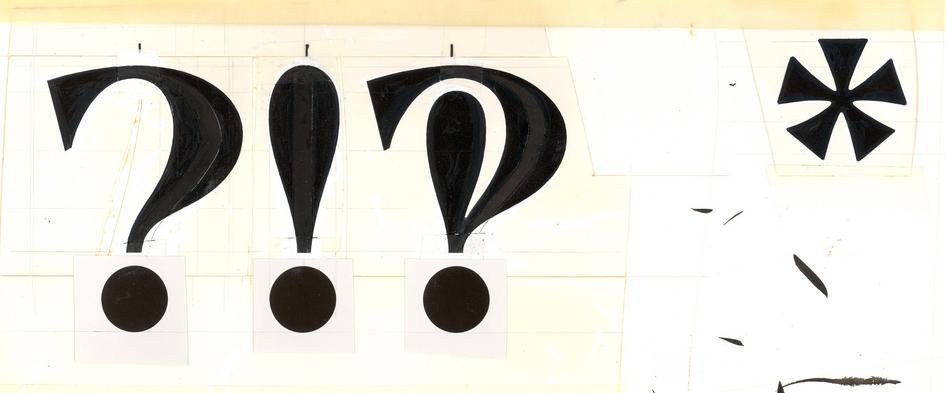A short entry today, but, I hope, a good one.
In the run-up to handing in the Shady Characters manuscript, I went through my notes one last time to check that I hadn’t missed anything. In doing so I came across a cryptic note about some of Richard Isbell’s original drawings for his font Americana, commissioned and sold by American Type Founders in honour of the USA’s impending bicentennial. I duly clicked on the accompanying link and was rewarded by an amazing set of Isbell’s drawings for the extra bold weight of this first interrobang-bearing font.
The ship has sailed on including the image in the book, unfortunately, but its loss is our gain: from the collection of Fritz Klinke of NA Graphics, Silverton, Colorado,1 here is the last of the interrobangs drawn by the man who first shepherded them into print:

Fritz acquired the image (and others like it, which you can see at his Flickr set of Isbell’s work) through his company, which in turn had purchased them at ATF’s 1993 bankruptcy auction.2 The fabric of the drawings themselves afford a glimpse into the pre-PC world of graphic design; as Fritz describes alongside the image:
Isbell used [photo]stats of the Bold version and cut them apart, expanding each character to the extra bold size and infilled the space with black India ink. Each character was then touched up with white and India Black where needed.3
And, via email:
All the marks on the scan are where Isbell was working the ink in his pen and similar marks occur on most of his other work. This artwork was shot on a camera and then an engraving pattern was made from the negative for use on the [pantographic] Benton engraving machine to produce a matrix for casting metal type.2
Americana Extra Bold was not only the final variant of that particular typeface, but also the the last hot metal typeface released by the once-mighty ATF. Given the rush from hot metal to the “cold type” of optical typesetting devices, the interrobang you see above may well have been the last ever to have been cut and cast in metal. You can read more about Isbell, Americana and the ATF’s slow demise elsewhere on Shady Characters.
My thanks go to Fritz Klinke for his permission to reproduce this fantastic image!
Coinciding neatly with the reappearance of the sci-fi drama Doctor Who on UK television screens, one-time Who script editor and novelist Andrew Cartmel recently wrote a short blog post bidding “Farewell My Lovely… Pilcrow”. Having used the pilcrow extensively in the past, Andrew confronts the difficulties in using the mark in its traditional role as a paragraph divider, concluding that “since I did a big publicity push for my new novel […] the last thing I wanted was a less-readable blog”.4 Do you agree? Is the pilcrow beyond saving as a common-or-garden mark of punctuation?
- 1.
-
Klinke, Fritz. “Fritz Klinke”. Briar Press, November 2004.
- 2.
-
Klinke, Fritz. “Personal Correspondence”. Keith Houston, 2012.
- 3.
-
Klinke, Fritz. “Richard Isbell’s Americana”.
- 4.
-
Cartmel, Andrew. “Farewell My Lovely. Pilcrow”.
Comment posted by Richard Polt on
I just saw this news item on fanfiction.net, where my daughter has been posting stories:
“Interrobang (!?) character is now supported for stories.”
Of course, this isn’t an actual interrobang, but I suppose the real thing can now be included in your fiction. This shows that there is a demand!
Comment posted by Keith Houston on
Hi Richard — I wonder what they mean by “supported”? Do they actually process stories somehow so that they conform to a particular, allowed set of punctuation?